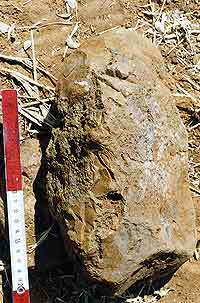
 |
|
|
Project Leaders:
|
Researchers:
Research Area:
|
|
|||||||
| Research Program: | (click to enlarge) | |||
|
The archaeological research in the northernmost part of Namibia has not been very elaborate so far. Nevertheless this area has had great influence on the discussions about the later prehistoric settlements in the entire South African region. This especially concerns in the eastern part (Kavango region) of northern Namibia the routes of the so-called „Bantu migrations“ and the spread of horticulture and iron technology and in the western part (Kaokoveld) the introduction of domesticated animals and pottery. The area offers an ideal regional focus, because it comprises different ecological settings for respective studies, as it ranges between the Atlantic and the Zambesi, and from desert to savannah and woodland conditions. Thus a primary aim of the project is to arrange several smaller study areas along a west-east transect in order to investigate strategies of adaptation and innovation under different environmental conditions. In the first phase of the project this demands long-range survey activities (including test excavations) that are carried out in close cooperation with botanists and geographers. Only after this, and after checking the archaeological potential and the state of preservation of organic materials (bones and botanical remains) more detailed archaeological studies can be carried out. Besides focusing on environmental and economical aspects and the modes of human adaptation, the project aims to contribute to a better chronological framework covering the last 3.000 years of human and environmental history in this area.
|
||||
Current Activities: Kaokoveld The excavated material from another rock shelter (Epupa 96/1) is not analysed yet, but the sequence seems to cover subrecent to Early Holocene material. Another site (99/1) is the only rock shelter with rock paintings in the Kaokoland. In addition the basal layer seem to contain MSA stone artefacts. If the preliminary assessment is confirmed by further analyses, the site 99/1 is the first stratigraphy in the Kaokoveld reaching back to the Pleistocene period.
|
||||
Current Activities: Kavango region
|
(click to enlarge)
|
|||
|
 Fig. 7 Stone hammer for quarry work |
| [Main]
[Project B1] [Project B4] [Project
B5] [Project B7]
|